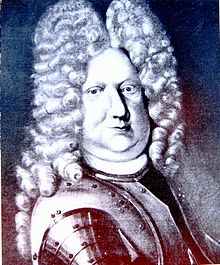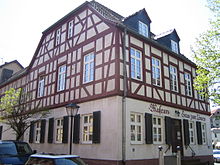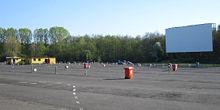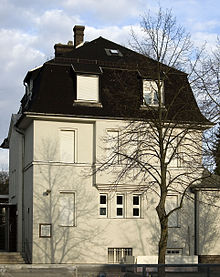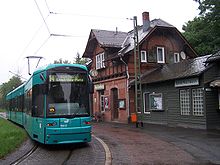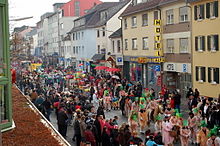- Neu-Isenburg
-
Neu-Isenburg 
Coordinates 50°03′N 8°42′E / 50.05°N 8.7°ECoordinates: 50°03′N 8°42′E / 50.05°N 8.7°E Administration Country Germany State Hesse Admin. region Darmstadt District Offenbach Town subdivisions 3 Stadtteile Mayor Herbert Hunkel Basic statistics Area 24.29 km2 (9.38 sq mi) Elevation 130 m (427 ft) Population 36,034 (31 December 2010)[1] - Density 1,483 /km2 (3,842 /sq mi) Other information Time zone CET/CEST (UTC+1/+2) Licence plate OF Postal code 63263 Area codes 06102,(Zeppelinheim:069) Website www.neu-isenburg.de The “Huguenot Town” of Neu-Isenburg with its outlying centres of Gravenbruch and Zeppelinheim is found in the Offenbach district in the Regierungsbezirk of Darmstadt in Hesse, Germany, right near Frankfurt am Main. It has 35,472[2] inhabitants (as at 31 December 2007).
The town is known nowadays mainly for its regionally used shopping centre, the Isenburg-Zentrum (IZ), the Hugenottenhalle, the Hotel Kempinski Frankfurt, the Autokino Gravenbruch (the oldest drive-in cinema in Europe), the Sportpark, the Waldschwimmbad (swimming pool) and not least of all its central location near Frankfurt Airport.
Contents
Geography
Neighbouring communities
Neu-Isenburg borders in the west and north on the district-free city of Frankfurt am Main, in the east on the district-free city of Offenbach and in the south on the towns of Dreieich, Langen and Mörfelden-Walldorf (Groß-Gerau district).
Constituent communities
In 1959, building work began on the Wohnstadt im Grünen (“Living Town in the Green”), as it was marketed. This was Gravenbruch. Almost 7,000 people found in this satellite town between the main town and Heusenstamm, lying in the woods, a new home. Owing to the great number of young families that moved there, this constituent community was known as the town with Europe’s densest population of children. It is also well known for the Kempinski-Hotel and the drive-in cinema.
With the amalgamation of the formerly self-administering community of Zeppelinheim in the course of municipal reform in 1977, Neu-Isenburg also stretched farther westwards. Here is found the Zeppelinmuseum.
History
Neu-Isenburg was founded on 24 July 1699 as a town of exiles by Huguenots, French Protestants who had had to flee their homeland after the Edict of Nantes was revoked. Their new landlord, Count Johann Philipp von Isenburg-Offenbach, guaranteed them safety, the free use of the French language and religious freedom.
He gave them leave to settle in the Wildbann Dreieich, an old royal hunting forest, in the place where in the Middle Ages the pilgrimage chapel Zum Heiligen Kreuz (“To the Holy Cross”) once stood. By way of thanks to the Count, the town was named Neu-Isenburg after him. The town plan was laid out by Andreas Loeber in a right-angled grid pattern. From corners ran diagonal streets to the marketplace. Also, the middles of the outer sides were linked by streets to the square marketplace. This township survives today in the streets of Kronengasse, Pfarrgasse, Löwengasse and Hirtengasse.
Neu-Isenburg was one of the planned towns of the 17th and 18th centuries. The settlers at first worked at farming, but later turned back to the handicraft trades that they had learnt, such as the stocking knitter’s craft, thereby laying the groundwork for Neu-Isenburg’s economic development. The surrounding communities eyed the French settlers with great mistrust and called the town welsches Dorf (the German word welsch refers to peoples who speak Romance languages, especially French; it is cognate with the English word Welsh, but does not have the same meaning).
On 20 May 1700 – a Thursday – the clergyman Isaac Bermond held the first church services under an old oak in the middle of the church square.
About 1701, the Forsthaus was built (today an inn called Frankfurter Haus) by the city of Frankfurt am Main at the city limits with Neu-Isenburg. The first French Reformed church was built of wood between 1702 and 1706. The foundation stone was laid on Ascension Day 1702. Likewise in 1702, the Town Hall was built at the marketplace, and the Haus zum Löwen was mentioned for the first time. This was used until 1918 as an inn called Au Lion d'Or (“At the Golden Lion”), and today it houses the local history museum.
The first school followed in 1704, and in 1705 the Bansamühle (mill). The wooden church was replaced between 1773 and 1775 with a stone building. In 1781, the first German-language school was built.
After the Congress of Vienna in 1815, the County of Ysenburg, together with the Oberamt of Offenbach and its member municipalities, passed to the Grand Duchy of Hesse. In 1828, the Prussian-Hessian Customs Union built a customs house (Frankfurter Straße 10) as its main customs office on the border with what was then the Free City of Frankfurt.
Despite considerable reservations, German families, too, were moving into the town beginning in the 18th century, leading to the church’s having to hold services alternately in German and French as of 1761, much to the French-speaking population’s chagrin. In the end, German was confirmed as the town’s official language in 1829.
In 1846, the Main-Neckar railway near Neu-Isenburg was completed, but the town did not get its own railway station until 1852.
Other events in Neu-Isenburg’s history, in brief, are as follows:
- 1860 The firm Müller markets Frankfurter Würstchen (sausages, but not the kind often called “Frankfurters” in the English-speaking world) for the first time.
- 1865 First postal station in Neu-Isenburg
- 1875 Volunteer fire brigade was founded
- 1885 The Waldeisenbahn, a steam tramway to Frankfurt, was opened (now tramline 14, and electric).
- 4 February 1889 Town rights were granted.
- 1889 The Waldbahn, a railway, began running to Frankfurt.
- April 1896 The Höhere Bürgerschule (now Goetheschule) took on its task as Neu-Isenburg’s first secondary school.
- 1899 On the occasion of its bicentenary, Neu-Isenburg received a coat of arms.
- 1907 The Jewish Women’s Federation’s home for Jewish girls was founded by Bertha Pappenheim.
- 23 October 1911 Consecration of the first Catholic church, St. Josef.
- Between 1943 and 1945 the town suffered heavy damage from air raids.
- 1945 A broad area in the town’s west had to be evacuated for the Occupying Power
- 1959 Building work began on Gravenbruch, a residential neighbourhood, after the woods there had been cleared.
- 1960 The Autokino Gravenbruch, Europe’s first drive-in cinema, was opened.
- 1 January 1977 Amalgamation of the formerly self-administering community of Zeppelinheim, which itself had been cobbled together from parts of the self-administering municipal areas of Mitteldick and Gundwald (the latter in Groß-Gerau district) and parts of the community of Kelsterbach on 1 January 1938.
- 1997 Neu-Isenburg was linked to the Rhine-Main S-Bahn.
Population development
In 1834, Neu-Isenburg had only 1,762 inhabitants. By 1939, there were 15,081. After Zeppelinheim was amalgamated and Gravenbruch had been built, the population reached 35,000 by 1983.
Politics
Town council
The municipal election held on 26 March 2006 yielded the following results:
Parties and voter communities %
2006Seats
2006%
2001Seats
2001CDU Christian Democratic Union of Germany 52.0 23 48.0 22 SPD Social Democratic Party of Germany 23.3 11 26.5 12 GREENS Bündnis 90/Die Grünen 14.4 6 16.9 8 FDP Free Democratic Party 5.4 3 5.2 2 FWG Freie Wähler Gemeinschaft Neu-Isenburg e.V. 5.2 2 3.4 1 Total 100.0 45 100.0 45 Voter turnout in % 42.4 46.3 Despite their absolute majority, the CDU still maintains the coalition with the Freie Wähler (“Free Voters”).
Mayors
Past mayoral elections have yielded the following results:
Year Candidates Party %
Result2010 Herbert Hunkel [E 1] 58,9 Christian Beck SPD 36,9 Susann Guber FDP 4,2 Voter turnout in % 38,4 2007 Dirk-Oliver Quilling CDU 83.3 Markus Munari SPD 16.7 Voter turnout in % 40.0 2001 Dirk-Oliver Quilling CDU 78.5 Wolfgang Lamprecht SPD 19.0 Edgar Schultheis 2.4 Voter turnout in % 41.1 Year Candidates Party %
Result1995[E 2] Dirk-Oliver Quilling CDU 63.1 Berthold Depper FDP 36.9 Voter turnout in % 38.0 1995 Dirk-Oliver Quilling CDU 49.5 Günter Trützschler SPD 14.1 Maria Marx Grüne 17.7 Berthold Depper FDP 18.8 Voter turnout in % 45.7 At the last election on 30 May 2010, the independent candidate Herbert Hunkel, who was supported by the CDU, won with 58.9% of the vote over Christian Beck (SPD, 36.9%), and Susann Guber (FDP, 4.2%). Voter turnout was 38.4%.
Town partnerships
 Weida, Thuringia
Weida, Thuringia Veauche, Loire, France
Veauche, Loire, France Andrézieux-Bouthéon, Loire, France
Andrézieux-Bouthéon, Loire, France Dacorum, Hertfordshire, England, United Kingdom
Dacorum, Hertfordshire, England, United Kingdom Bad Vöslau, Lower Austria, Austria
Bad Vöslau, Lower Austria, Austria
Town friendships
Economy and infrastructure
Economy
Given its proximity to the trade fair city of Frankfurt and to Frankfurt Airport, Neu-Isenburg is an attractive location for businesses of the most varied sectors. Among them are many hotels, which see more than 230,000 overnight stays every year, the highest figure in the Offenbach district.
Over time, the town has converted itself from a location for producing businesses to a service-industry-based location and is among the biggest high-technology locations in the Frankfurt Rhine Main Region.
Some of the businesses established here are:
- ARAMARK Holdings GmbH & Co. KG
- eprimo GmbH
- Jeppesen GmbH
- Kempinski Frankfurt AG
- Lorenz Snack-World GmbH (Bahlsen)
- Lufthansa Service GmbH (LSG Sky Chefs)
- Lufthansa AirPlus Servicekarten GmbH
- Pepsi-Cola GmbH
- Symantec Corporation
- Keyence Deutschland GmbH
- UL International Germany GmbH
- Sescoi GmbH
- Alpha Industries GmbH & Co. KG
- Banque PSA Finance, SA.
- KarstadtQuelle Bank
- G. A. Müller GmbH (meat products factory, oldest manufacturer of the original Frankfurter Würstchen)
- Hans Wirth GmbH & Co. KG (meat products factory, manufacturer of the original Frankfurter Würstchen)
- Druck- und Verlagshaus Frankfurt am Main GmbH (publishing and printing house of the Frankfurter Rundschau)
In addition, a branch of the state distilling monopoly (the Branntweinmonopol) is located in Neu-Isenburg at Schleussnerstraße 6.
Around the 1980s and 1990s Condor Flugdienst was headquartered in Neu-Isenburg.[3][4]
Transport
The town is close to several routes of the German Autobahn network (A 3, A 5, A 661).
It also has a station on the Rhine-Main S-Bahn system, served by S-Bahn lines S3 and S4, although the station is somewhat remote from the town centre. Route S7 serves Zeppelinheim.
The Frankfurt tram network has a terminal at Isenburger Schneise, just within the Frankfurt boundary for reasons of municipal identity, linking the northern margin of Neu-Isenburg with Frankfurt city centre and Frankfurt-Bornheim by way of Frankfurt South railway station.
Frankfurt Airport lies at the town limits, and the Neu-Isenburg railway station is the only one in Hesse that has loading tracks for a motorail service, connecting to several destinations in Austria, Italy and southern France.
Culture and sightseeing
Hugenottenhalle
Neu-Isenburg is known far beyond its limits for the various events staged at the Hugenottenhalle. In this multipurpose hall with a variable capacity of up to 2,000 people, rock concerts are held, guest theatrical performances are given and dancing and music are performed. Citizens are offered a comprehensive cultural programme covering every genre.
Open-Doors-Festival
Neu-Isenburg is especially well known in the Frankfurt Rhine Main Region for its yearly summertime Open-Doors-Festival (formerly Musikspektakel). For three days, some 40 different bands and artists from all genres of music play. The event is attended by some 15,000 guests who enter free of charge, and is held on several different stages throughout the town area.
Fastnacht
The parade on Shrove Monday (Rosenmontag) – sometimes called Lumpenmontag in Neu-Isenburg – running across the town enjoys great popularity.
Education
- Primary schools
- Albert-Schweitzer-Schule [1]
- Hans-Christian-Andersen-Schule
- Wilhelm-Hauff-Schule
- Ludwig-Uhland-Schule, Gravenbruch
- Selma-Lagerlöf-Schule, Zeppelinheim
- Comprehensive school
- Brüder-Grimm-Schule [4]
- Special school
- Friedrich-Fröbel-Schule, school for learning help and speech therapy
- Other schools
- Music school
- folk high school [5]
Famous people
- Anny Schlemm, opera singer
- Peter Dietrich, former national football player with Borussia Mönchengladbach, world championship participant 1970
- Hannelore Jacob, youngest member of the hit singing group, the Jacob Sisters
- Bertha Pappenheim, feminist and social worker
- Thomas Reiter, ESA astronaut and longtime occupant of the International Space Station and Mir
- Horst Ludwig Störmer, Nobel Prizewinner in physics (1998)
- Franz Völker, German singer (tenor)
- Volker Steinbacher, artist and graphic artist
References
- ^ "Die Bevölkerung der hessischen Gemeinden" (in German). Hessisches Statistisches Landesamt. 31 December 2010. http://www.statistik-hessen.de/static/publikationen/A/AI2_AII_AIII_AV_10-1hj_pdf.zip.
- ^ http://www.statistik-hessen.de/themenauswahl/bevoelkerung-gebiet/regionaldaten/bevoelkerung-der-hessischen-gemeinden/index.html
- ^ "World Airline Directory." Flight International. 30 March 1985. 70." Retrieved on 17 June 2009.
- ^ "World Airline Directory." Flight International. 24-30 March 1993. 84." Retrieved on 30 September 2009.
External links
- Town’s official webpage (German)
- Hugenottenhalle cultural link (German)
- Verein für Geschichte Heimatpflege und Kultur (German)
- Herkunft des Isenburger Wappens (English)
- Neu-Isenburg at the Open Directory Project (German)
- This article incorporates information from the German Wikipedia.
Dietzenbach | Dreieich | Egelsbach | Hainburg | Heusenstamm | Langen | Mainhausen | Mühlheim am Main | Neu-Isenburg | Obertshausen | Rödermark | Rodgau | SeligenstadtCategories:- Towns in Hesse
Wikimedia Foundation. 2010.





